 |
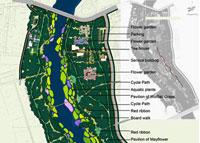 |
 |
 |
The site plan. (Photo: Kongjian Yu, Cao Yang) |
 |
 |
 |
 |
 |
 |
The site has lush riparian vegetation but is unsafe and inaccessible, the whole area is unkempt and deserted, and is under the pressure of urbanization and river channelization. (Photo: Kongjian Yu, Cao Yang) |
 |
 |
 |
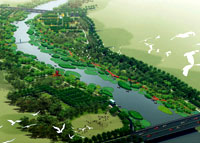 |
 |
 |
Computer-rendered bird's eye view of the park. (Photo: Kongjian Yu, Cao Yang) |
 |
 |
 |
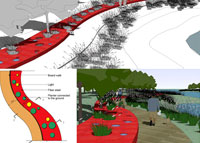 |
 |
 |
The red ribbon made of fiber steel that integrates multiple functions of lighting, seating, environmental interpretation, and orientation.
(Photo: Kongjian Yu, Cao Yang) |
 |
 |
 |
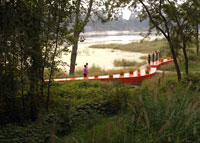 |
 |
 |
The red ribbon along the river with minimal disturbance to the native vegetation. Animal crossings are built into the ribbon for small animals. A formerly inaccessible waterfront becomes an attraction to the nearby residents. (Photo: Kongjian Yu, Cao Yang) |
 |
 |
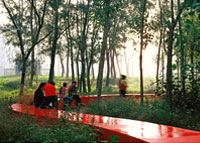 |
 |
 |
The red ribbon runs through the grove and bends with the terrain. (Photo: Kongjian Yu, Cao Yang) |
 |
 |
 |
 |
 |
The red ribbon as a gathering place: The natural site has been dramatically urbanized and modernized, two attributes highly sought after by the local residents, many of whom are former farmers and newly urbanized, while keeping the ecological processes intact. (Photo: Kongjian Yu, Cao Yang) |
 |
 |
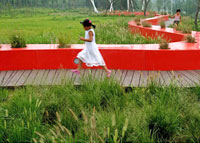 |
 |
 |
The red ribbon runs across open the field of a former garbage dump. (Photo: Kongjian Yu, Cao Yang) |
 |
 |
 |
 |
 |
 |
 |
 |
 |
 |
|
Click here for printer-friendly version |
 |
Project Statement
The Minimum Intervention Approach
to Urban Greenway
Against a background of natural terrain and vegetation,
is a “red ribbon” spanning five hundred
meters, which integrates the functions of lighting,
seating, environmental interpretation, and orientation.
While preserving as much of the natural river corridor
as possible during the process of urbanization, this
project demonstrates how a minimal design solution can
achieve a dramatic improvement to the landscape.
Project Narrative
1. Site Conditions and Challenges
The project was located on the Tanghe River, at the
east urban fringe of Qinhuangdao City, Hebei Province,
China. The site is a linear river corridor, with a total
area of about 20 hectares.
The following site conditions offered
both opportunities as well as challenges for the design
of this site:
(1) Good Ecological Condition: The site was covered
with lush and diverse native vegetation that provides
diverse habitats for various species.
(2) Unkempt and Deserted: Located at the edge of a
beach city, the site was a garbage dumping site with
deserted slums and irrigation facilities such as ditches
and water towers that were built for farming years
ago.
(3)Potential safety and accessibility problems: distributed
with lush shrubs and “messy” grasses,
the site was virtually inaccessible and insecure for
people to use.
(4) Use Demands: Along with the urban sprawl process,
the site was sought after for recreational uses such
as fishing, swimming, and jogging by the people who
came to reside in the newly developed communities
nearby.
(5) Development Pressure: The lower reaches of this
river have already been channeled, and this process
was likely to happen again at the site, meaning the
natural river corridor was likely to be replaced with
hard pavement and ornamental flower beds unless the
new red ribbon design was implemented.
2. Design objectives
The major design challenge was how to preserve the natural
habitats along the river while creating the new urban
uses of recreation and education. The solution is the “red ribbon.”
3. Design solution
A “red ribbon” was designed against the
background of green vegetation and blue water. This
ribbon stretches for 500 meters along the riverbank,
integrating a boardwalk, lighting, seating, environmental
interpretation, and environmental orientation. It is
made of fiber steel, and lit from inside so that it
glows red at night. It stands 60 cm high, and its width
varies from 30-150 cm. Various plant specimens are grown
in strategically placed holes in the ribbon.
Four pavilions in the shape of clouds
are distributed along the ribbon, which provide protection
from the weather, meeting opportunities, and visual
focal points. Four perennial flower gardens of white, yellow, purple,
and blue, act as patchwork on the former open fields,
and turn the deserted garbage dumps and slum sites into
attractions.
The bright red color of the ribbon lights
up this densely vegetated site, links the diverse natural
vegetation types and the four added flower gardens,
and provides a structural instrument that reorganizes
the former unkempt and inaccessible site. The natural
site has been dramatically urbanized and modernized,
two attributes that are highly sought after by the local
residents while keeping the ecological processes and
natural services of the site intact.
 |
 |
Project
Resources |
 |
 |
Principal Designer:
Kongjian Yu
Landscape
Architect:
Lin Shihong, Chen Chen, Niu Jin, Hong Wei, He Jun, Ning Weijiing, Li Yao
Architect:
Liu Xiangjun, LongXiang, Yang Zhenrong
|
 |
 |
 |
Environmental
Artist:
Yang Lina, Jiang Hongfen, Jin Zhongge, Fu Xiujun, Ji Lianzhong, Hou Erbin
Graphic Artist:
Men Yujia, Luo Shuishui
|
 |
 |
 |
|
|
|
|
 |
 |
 |
 |
 |
 |
Red ribbon runs across a former garbage dump and has a strong contrast with the native wolf tail grass. (Photo: Kongjian Yu, Cao Yang) |
 |
 |
 |
 |
 |
 |
The red ribbon and one of the four pavilions, each of which is named after a native grass species, and is integrated with environmental interpretative design. (Photo: Kongjian Yu, Cao Yang) |
 |
 |
 |
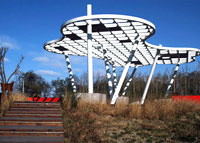 |
 |
 |
A winter scene of The Pavilion of Wolftail Grass, one of the four steel pavilions named after native grass.
(Photo: Kongjian Yu, Cao Yang) |
 |
 |
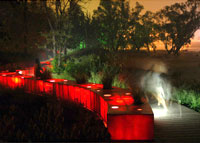 |
 |
 |
The red ribbon acts as a lighting facility during the night and gives orientation across the forest.(Photo: Kongjian Yu, Cao Yang) |
 |
 |
 |
 |
 |
The red ribbon during the winter as it winds across a seedling patch left over from a former tree nursery. (Photo: Kongjian Yu, Cao Yang) |
 |
 |
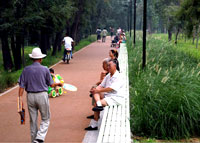 |
 |
 |
The cycle path is built on the former dirt road, the long bench was built on the former irrigation ditch wall, the former unkempt place has become an attraction to local people of all ages. (Photo: Kongjian Yu, Cao Yang)
|
 |
 |
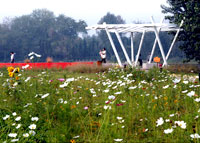 |
 |
 |
One of the flower gardens built on the formerly deserted land, with the red ribbon and Pavilion of Silver Grass. (Photo: Kongjian Yu, Cao Yang)
|
 |
 |
|
 |